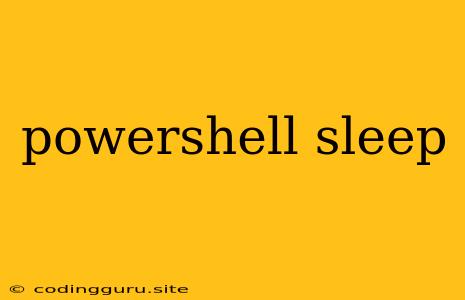Introducing PowerShell Sleep
PowerShell is a powerful automation tool for managing Windows systems. One common task in scripting is introducing pauses or delays. This is where the PowerShell Sleep command comes in handy.
Why Use PowerShell Sleep?
Imagine you need to automate a task that involves multiple steps. Some steps might take longer than others, and you want to ensure the script waits for a specific process to complete before moving on. This is where the Sleep command is crucial.
Understanding the Syntax
The Sleep command in PowerShell is straightforward:
Start-Sleep -Seconds
Replace <Number of Seconds> with the desired duration of the pause in seconds. For example, to pause your script for 10 seconds, you'd use:
Start-Sleep -Seconds 10
Practical Applications
Here are some scenarios where using Sleep can be advantageous:
- Waiting for a Process: You can use
Sleepto wait for a specific process to complete before continuing your script. For example:# Start a lengthy process Start-Process -FilePath "your_process.exe" # Wait for 30 seconds for the process to complete Start-Sleep -Seconds 30 # Continue with the script - Rate Limiting: If you need to perform actions at a specific rate, you can incorporate
Sleepto control the frequency. - User Feedback: You can use
Sleepto pause your script and display messages to the user, providing feedback on the progress of the automation.
Tips for Using PowerShell Sleep:
- Precision: The
Sleepcommand offers second-level precision. While it might not be perfect for real-time applications, it's sufficient for most scripting scenarios. - Alternative Units: While the
-Secondsparameter is common, you can also use-Millisecondsfor finer control.
Beyond the Basics
PowerShell offers advanced techniques for managing time in scripts, including:
- Get-Date: This cmdlet helps retrieve the current date and time, allowing you to create time-based conditional logic.
- System.Threading.Thread.Sleep: This .NET method offers greater control over sleep duration, including the ability to specify sub-second delays.
Conclusion
The Sleep command is a powerful tool in your PowerShell scripting arsenal. By understanding its syntax and practical applications, you can streamline your automation efforts and build more robust scripts. Incorporate Sleep into your scripts when you need to introduce pauses, manage timing, and ensure a seamless flow of execution.
